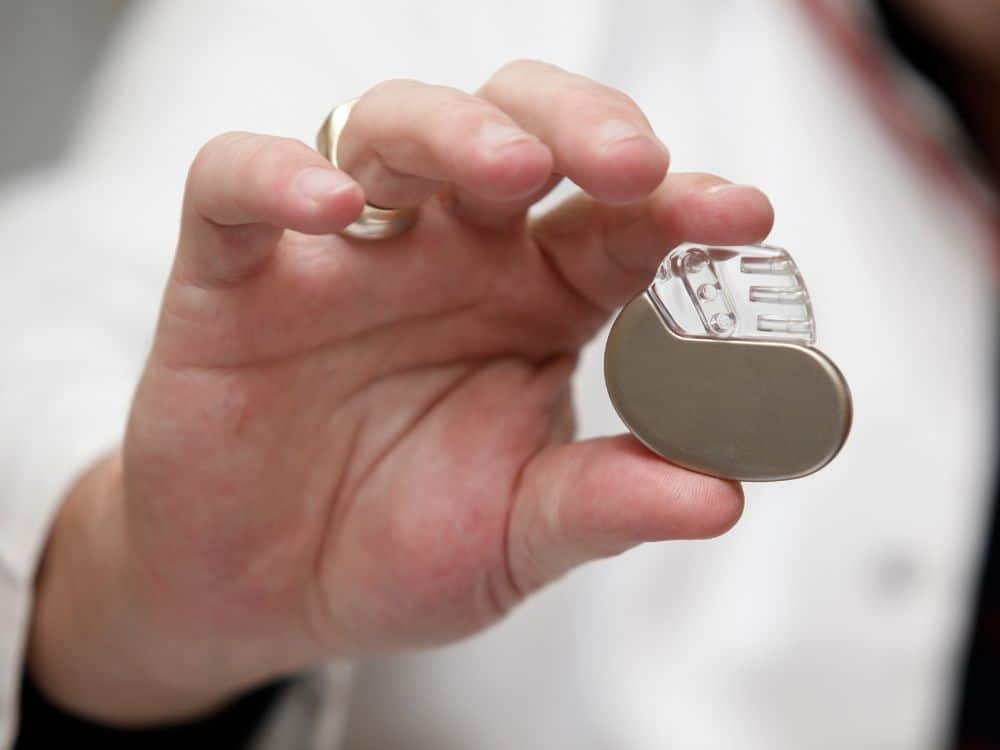Do you have a pacemaker and are wondering about its battery life? Or perhaps your loved one is about to get one, or your doctor told you that you might need one, and you are wanting to ease some of your worries and learn more about these amazing little devices.
Either way, we have got you covered in this blog post. Here, we will cover all aspects of a pacemaker’s battery life including symptoms of a low battery and also some replacement options. We will also cover potential risks associated with having a pacemaker, such as infection, pacemaker syndrome, and electromagnetic interference.
Read on to learn more about how long pacemakers last before needing to be replaced!
Table of Contents
What Are the Symptoms of Low Pacemaker Battery?
What is a Pacemaker?
Also referred to as a “cardiac pacing device,” a pacemaker is a small implant that is inserted into the skin on your chest above your abdomen during surgery. It is battery-powered and it helps regulate your heart rate to ensure it’s beating at the right rhythm for optimal health. It does this by sending small electrical pulses to the heart to keep the steady rhythm going.
There are a few different kinds of pacemakers on the market today. There is a single chamber pacemaker, which sends those pulses to one heart chamber, generally the right ventricle. Then there is the dual chamber pacemaker, which sends the electrical pulses to not only the heart’s right ventricle, but also to the heart’s right atrium.
Lastly, there is the biventricular pacemaker, which helps people who have heart failure. Another name for this device is cardiac resynchronization therapy. It sends pulses to both of the heart’s lower right and left chambers.
Symptoms of Low Pacemaker Battery
The battery in a pacemaker has an average battery life span of ten to twelve years before it needs to be replaced. Let’s look at some symptoms that can indicate a low pacemaker battery:
1. Lightheadedness
One thing you might experience with a low pacemaker battery is lightheadedness. This can be caused by the pacemaker not being able to provide enough electrical pulses to keep your heart rate at a normal pace.
2. Fainting
Another symptom is fainting or syncope. Just like the symptom above, this occurs when the pacemaker is not providing enough electrical pulses to keep your heart rate steady, resulting in a drop in blood pressure. A drop in blood pressure can cause you to feel faint or even pass out.
3. Dizziness or Confusion
Dizziness or confusion can also occur as symptoms of a low pacemaker battery. This is because when the pacemaker is unable to keep up with the demands of your heart rate, blood cannot reach the rest of your body fast enough. Not enough blood to the head can cause dizziness or confusion.
4. Trouble Breathing or Chest Pain
Also, trouble breathing can indicate a low pacemaker battery. This is because when your heart rate is not regulated properly, or if fluid begins to pool in your lungs, then you may experience symptoms like shortness of breath or chest pain due to the heart laboring to pump enough blood.
5. Fast or Slow Heart Rate
A fast heart rate or slow heart rate is another symptom of a low pacemaker battery. Similarly, heart palpitations can occur. When the pacemaker is not working like it should and the battery is failing, it may cause your heart to beat too slowly or too quickly.
What to Do If You Experience Symptoms
No one wants to find themselves in a situation where they experience symptoms of a low pacemaker battery, or worse, experience pacemaker failure due to a dead battery, so it’s important to be aware of what symptoms you might experience.
If you do experience symptoms like those mentioned above, then your battery may be running low and you should be given an evaluation immediately by your healthcare provider.
Your provider may immediately recommend a pacemaker replacement surgery, or he or she may opt to do an x-ray to check the pacemaker battery and pocket for signs of infection or fracture first. If symptoms are caused by a low battery, then a replacement pacemaker with a new battery can be inserted.
How Can I Protect My Pacemaker Battery?
There are several steps you can take to protect your pacemaker battery. Be sure to keep your regular appointments with your healthcare provider for pacemaker check-ups and carry your pacemaker ID just in case.
Also avoid activities that use power generators, such as arc welding, and keep your pacemaker away from devices with a strong magnetic field, such as cell phones, metal detectors, and headphones. This is called electromagnetic interference. Generally, electrical products like electric blankets, microwaves, and appliances, however, are considered safe.
It may sound like a lot to take in, process, and handle on a day to day basis. But don’t worry. Your healthcare provider will give you specific instructions on how to care for your pacemaker and will let you know when it’s safe to participate in certain daily activities or exercise.
When Should I Replace My Pacemaker Battery?
If symptoms related to a low pacemaker battery occur, your healthcare provider may recommend replacing the battery. The procedure for replacing the pacemaker typically is about two hours long and is usually done on an outpatient basis (unless the pacemaker lead also needs replacing). You’ll receive local anesthesia and sedation to keep you comfortable during the surgery.
Your pacemaker will be removed from its pocket and then a new pulse generator containing a fresh battery will be inserted.
The recovery time for this procedure varies depending on the individual. After the replacement procedure, your healthcare provider will monitor your heart rate to make sure everything is working correctly.
Why Are Pacemakers Recommended?
Pacemakers are often recommended for people for many different reasons. This is especially the case with certain medical conditions that causes a person’s heart to not beat like it should.
You may need a pacemaker if you are experiencing any of the following:
- Your heartbeat is too fast or slow.
- Your heart rhythm is irregular (such as from a genetic condition).
- You have heart muscle damage (such as from a heart attack).
- Your heart’s electrical system is aged or compromised in some way.
Sometimes doctors will recommend a pacemaker temporarily, such as in the case where a patient’s heart needs a little support while it is expected to make a full recovery. But many times, pacemakers are recommended on a more permanent basis.
Medical Conditions that May Require a Pacemaker

Here is a brief list of some of these medical conditions that may require a pacemaker to be implanted in a person:
Congestive Heart Failure
Congestive heart failure is a medical condition where the heart cannot pump enough blood to meet the body’s needs. This can cause symptoms such as shortness of breath (due to fluid backing up in the lungs), fatigue, frequent cough, and swelling in your extremities.
Sick Sinus Syndrome
Sick sinus syndrome is an uncommon disorder in which your heart’s electrical signals cause a slow heart rhythm, or irregular heartbeats (also called arrhythmia), or even long pauses between beats. Symptoms may include fainting, dizziness, and heart palpitations.
Heart Block
Heart block (also known as atrioventricular block or AV block) is a condition where the electrical signal cannot travel from the atrium (upper chamber) to the ventricle (lower chamber). This can cause symptoms such as syncope (sudden loss of consciousness), nausea, and fatigue.
Syncope
Syncope is a medical condition where a person experiences a sudden and brief loss of consciousness. This can happen when there is hypertension (low blood pressure) or various heart conditions such as ventricular tachycardia. It can be accompanied by lightheadedness and dizziness.
Arrhythmia
Briefly mentioned earlier, arrhythmia is an umbrella term for any condition where your heart’s electrical system misfires or produces abnormal signals. It causes palpitations and sometimes also chest discomfort or lightheadedness.
Atrial Fibrillation
Atrial fibrillation (also known as A-fib) is a condition where the atria (upper chambers) of your heart beat out of rhythm and very rapidly. This can cause blood clots to form in a person’s bloodstream and can lead to serious conditions like strong or heart failure. It is known to cause shortness of breath, palpitations. and dizziness.
How to Check if You Need a Pacemaker
You may be wondering how you would know if you should get a pacemaker implanted. If you don’t know if you need one or not, then an electrocardiogram (ECG) can help determine if you need a pacemaker implantation procedure. It is a safe, fast, and non-invasive procedure that typically only lasts about five to ten minutes.
Conclusion
In conclusion, if you have a pacemaker and are showing symptoms indicating a low battery, then it’s best to get the device checked out by a healthcare provider right away. They can determine whether or not you need to replace the pacemaker battery.
Taking precautions such as staying away from power generators and strong magnetic fields can help prolong the life of your pacemaker battery, but if replacement becomes necessary, make sure you follow all instructions provided by your healthcare provider for optimal recovery.
Hang onto hope. You can do this. Tell us about your pacemaker story in the comments – we’d love to cheer you on!
